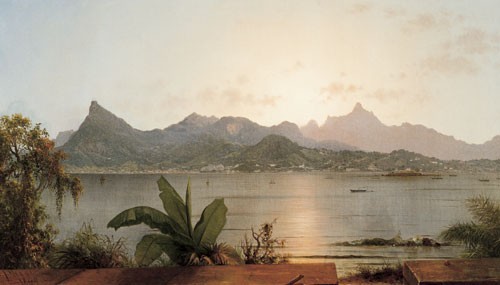
Martin Johnson Heade, Sunset Harbor at Rio, 1864. Oil on canvas, 20 1/8" x 35". (Courtesy, Pennsylvania Academy of the Fine Arts, Henry C. Gibson Fund.)

William J. Bennett, Bowling Green, north on the west side of Broadway, New York City. Aquatint, 13 1/2" x 9 3/8". (© Collection of the New-York Historical Society.) Bennett’s view depicts Bowling Green about 1826. No. 1 Broadway is the first house on the left in the foreground and has a pedimented, projecting center bay. According to Iconography of Manhattan Island, 6 vols. (New York: Robert H. Dodd, 1915–1928), 3: 589–90, No. 1 Broadway was the site of a boarding school for young ladies before Innocent Loring established her fashionable boardinghouse. It became the private residence of Robert Kennedy in 1798 and Nathaniel Prime in 1810.
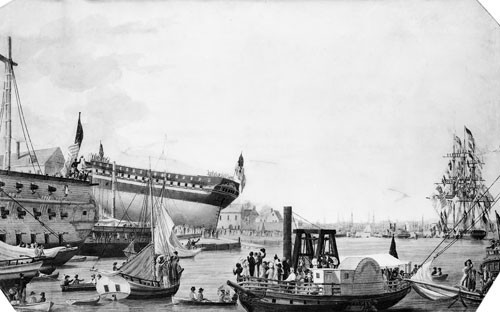
Launch of the Battleship Ohio at the New York Navy Yard, Brooklyn, Tuesday Morning, May 30, 1820, attributed to William J. Bennett, New York City. Watercolor, 14 1/4" x 23". (© Collection of the New-York Historical Society.) The ship’s figurehead depicting Hercules, carved by Jeremiah Dodge (1781–1860) and Cornelius Sharp (active ca. 1810–d. 1828), is in the collection of the Peabody Essex Museum, Salem, Massachusetts.

Page 1 in Elisha Blossom, Jr., Daybook, Rio de Janeiro and New York, 1811–1818. (© Collection of the New-York Historical Society.) This daybook was half of a two-part bookkeeping system that also included an alphabetized ledger where daily credits and debits were totaled up under the names of the individual with whom Blossom made transactions. The ledger is missing.

Cradle, New York City, 1815–1825. Mahogany and mahogany and rosewood veneers with white pine; brass inlay. L. 45". (Courtesy, Metropolitan Museum of Art, Sylmaris Collection; gift of George Coe Graves, by exchange.) The crotch mahogany veneer on the dome, separated by brass line inlay, radiates from a brass star inlaid at the center in a rosewood field; the dome is lined with the original cream-colored silk. Matching silk or mull draperies, suspended from the dome, very likely completed the cradle’s sumptuous original decorative scheme.
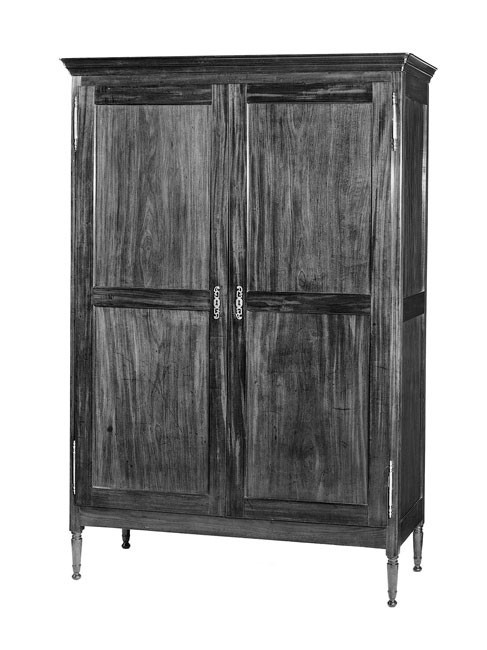
French press, New York City, ca. 1810. Mahogany with yellow poplar and white pine. H. 83 1/2", W. 54 1/2", D. 20 3/4". (Courtesy, Boscobel Restorations, Inc.)

French sideboard, New York City, 1810–1820. Mahogany and mahogany veneer with yellow poplar. H. 57 1/2", W. 73 3/8", D. 25 1/2". (Courtesy, New York State Museum; partial gift of the Wunsch Foundation.)

Pembroke table, New York City, 1810–1820. Mahogany and mahogany veneer with white pine and cherry. H. 28 3/4", W. 35 3/4", D. 48 3/4" (open). (Courtesy, Metropolitan Museum of Art.)

Detail of the side apron of the table illustrated in fig. 8, showing the two hinged “flys” that support the leaf. In the 1810 New York price book only one “fly” on each side was standard for both turned leg and pillar-and-claw pembroke tables. A charge of 1s.4p. was assessed for each additional fly.
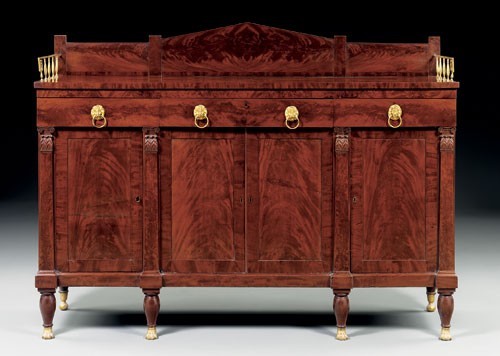
French sideboard, possibly by William Turner, New York City, 1813. Mahogany and mahogany veneer with unrecorded secondary woods. H. 35 1/2" (to top), W. 77 1/4", D. 22 3/4". (Courtesy, Christie’s.) The sideboard has a partial label that states: “AK[ER]/No. 50 Beekman Street/ New York/ All orders Thankfully Received and Favor[ably] attended to/ May, 1813.” William Turner was listed at this address in the 1813 New York City directory.

Charles-Honoré Lannuier (1779–1819), French sideboard, New York City, 1812–1819. Mahogany and mahogany veneer with yellow poplar, mahogany, white pine, ash; vert antique. H. 57", W. 76 3/8", D. 27 3/4". (Courtesy, Metropolitan Museum of Art; gift of Fenton L. B. Brown.)
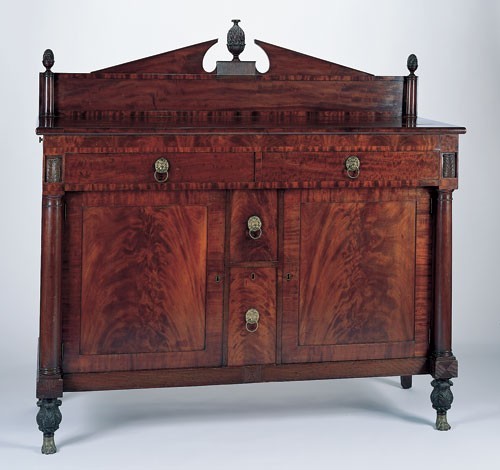
French sideboard, New York City, 1810–1820. Mahogany and mahogany veneer with white pine. H. 59 3/4", W. 61 3/8", D. 22 1/4". (Courtesy, Museum of Art, Rhode Island School of Design; bequest of Martha B. Lisle, by exchange; photo, Erik Gould.) The addition of two tall, narrow bottle drawers between the cupboard doors is frequently found on small-form French sideboards from New York.

Charles Christian (active in New York 1798–1826), Pembroke table, New York City, 1816-1817. Mahogany and mahogany veneer. H. 29" (approximately), W. 36", D. 43 3/4" (open). (Courtesy, Christie’s.)
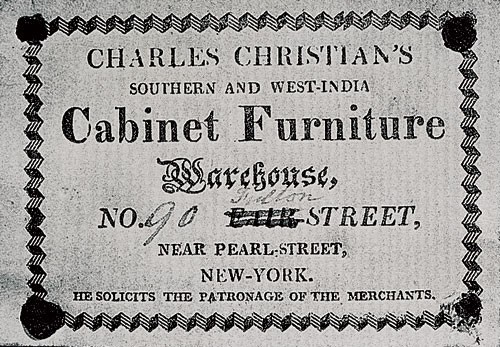
Detail showing the label on the Pembroke table illustrated in fig. 13. Partition and Fair Streets were joined to form Fulton Street in 1816. When this occurred, Christian’s Fair Street address changed to 90 Fulton Street, and he adjusted his label in ink accordingly. In May 1817 he moved his shop to No. 58 Fulton.

Folio 112 in Elisha Blossom, Jr., Daybook. This page records Blossom’s work on a Pembroke table for Charles Christian under the date September 27. Blossom credited Christian $5.00 for a cash payment three days earlier.

Transcriptions from the Elisha Blossom, Jr., Daybook and the 1810 New York cabinetmakers’ book of prices showing side-by-side comparison of the “Writing table and Book case” Blossom made for Charles Christian and the price book entry for the same form, which Blossom used as the basis for his charges.
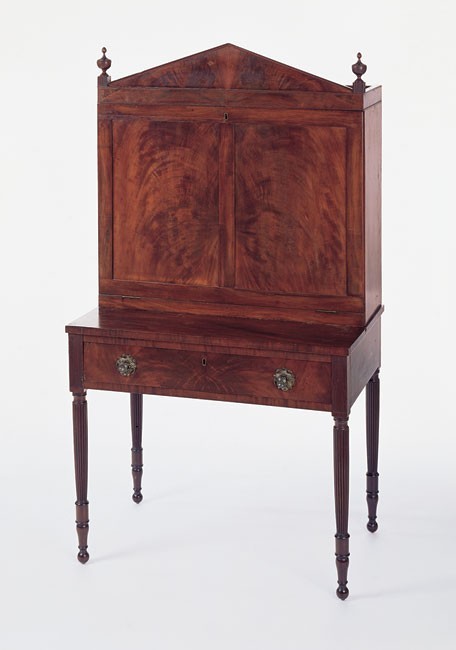
Writing table and bookcase, New York City, 1810–1820. Mahogany and mahogany veneers with white pine. H. 66", W. 36 1/2", D. 23". (Courtesy, New York State Museum.)

Title page from The New-York Revised Prices for Manufacturing Cabinet and Chair Work, June, 1810. (Courtesy, Winterthur Library: Printed Book and Periodical Collection.) This page from Duncan Phyfe’s personal copy depicts a pedestal-end sideboard that was more Angloinspired than the “French sideboard” also listed (for the first time) in the 1810 price book. During the early 1810s, elite New Yorkers probably considered the latter form more avant-garde.
